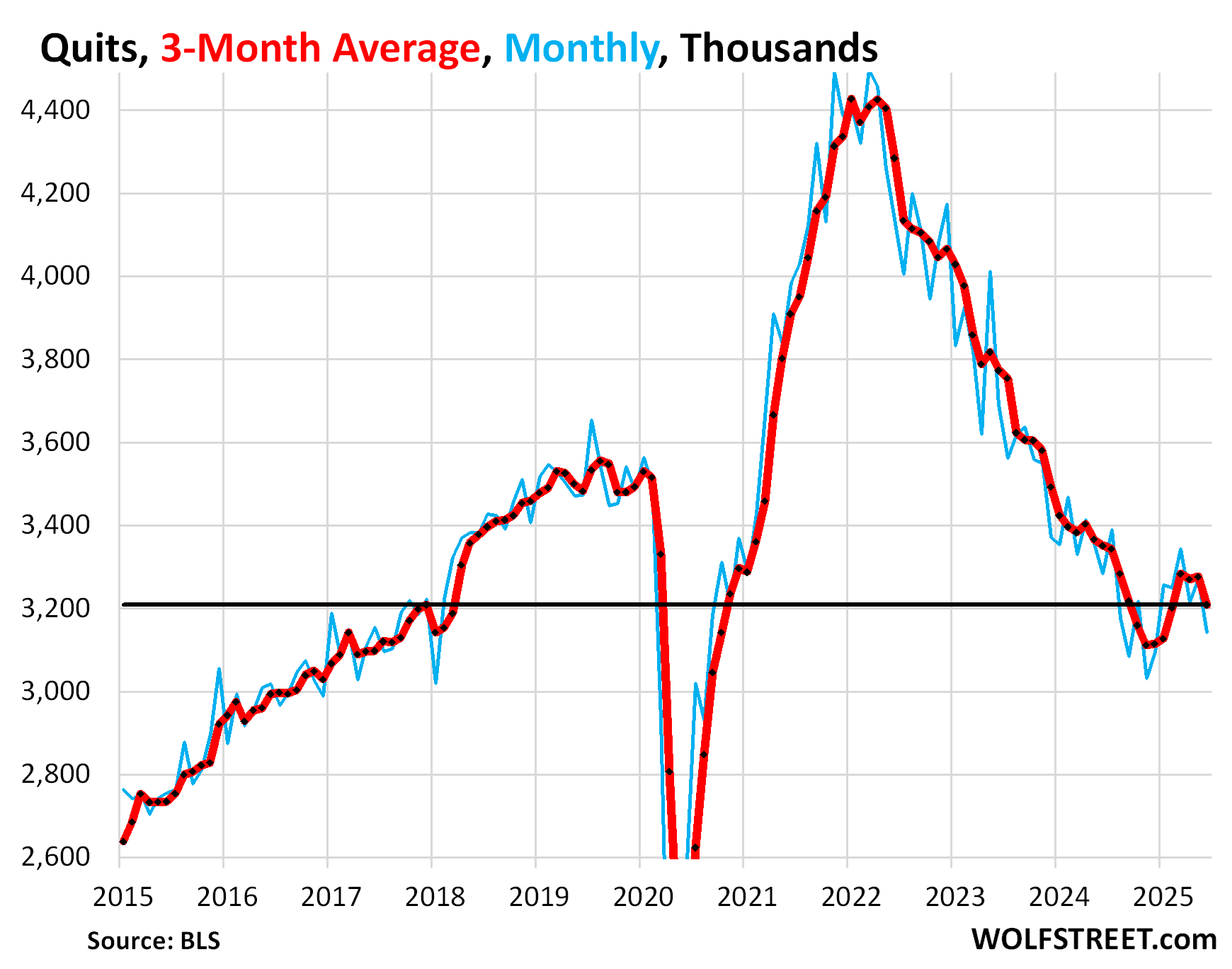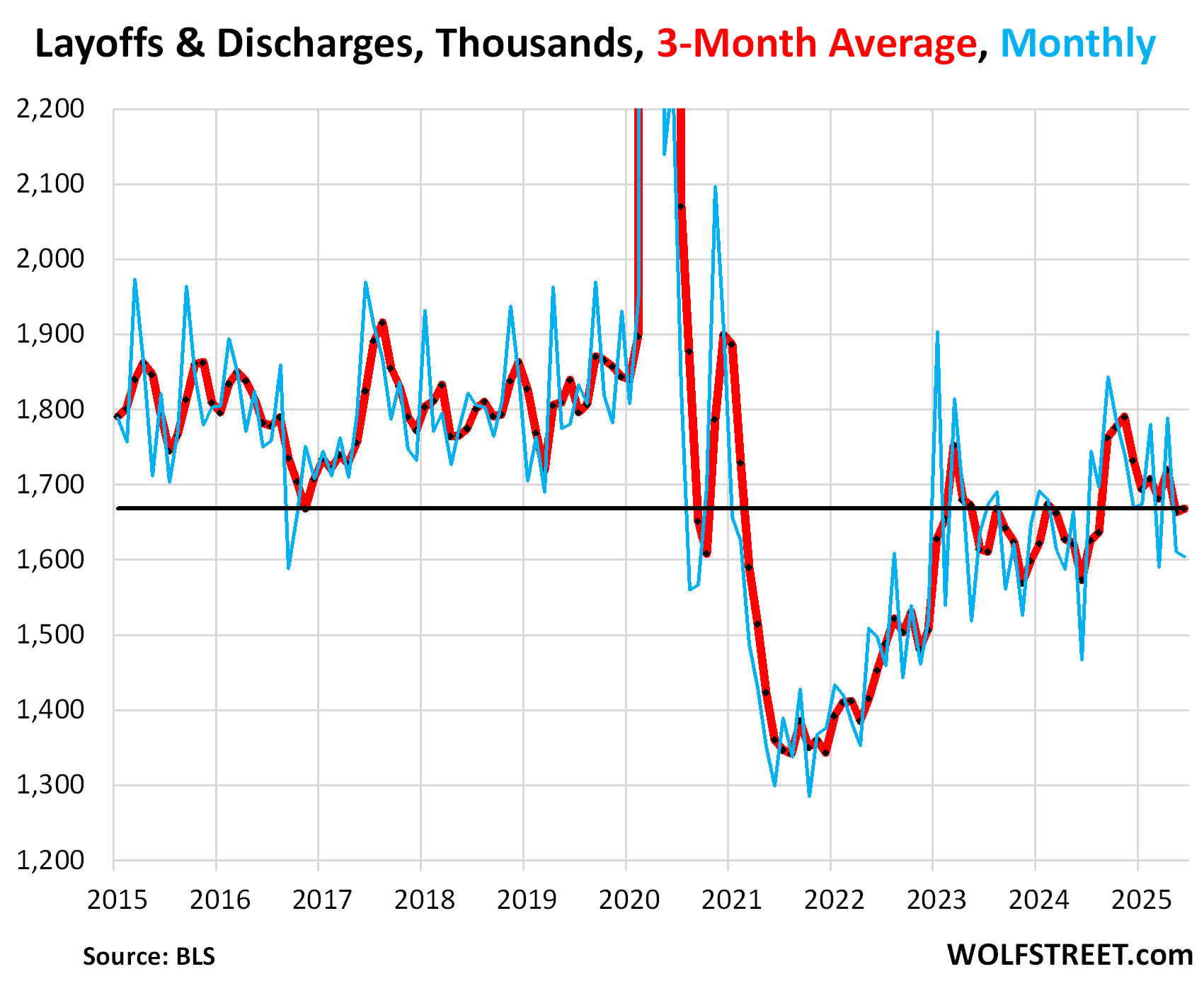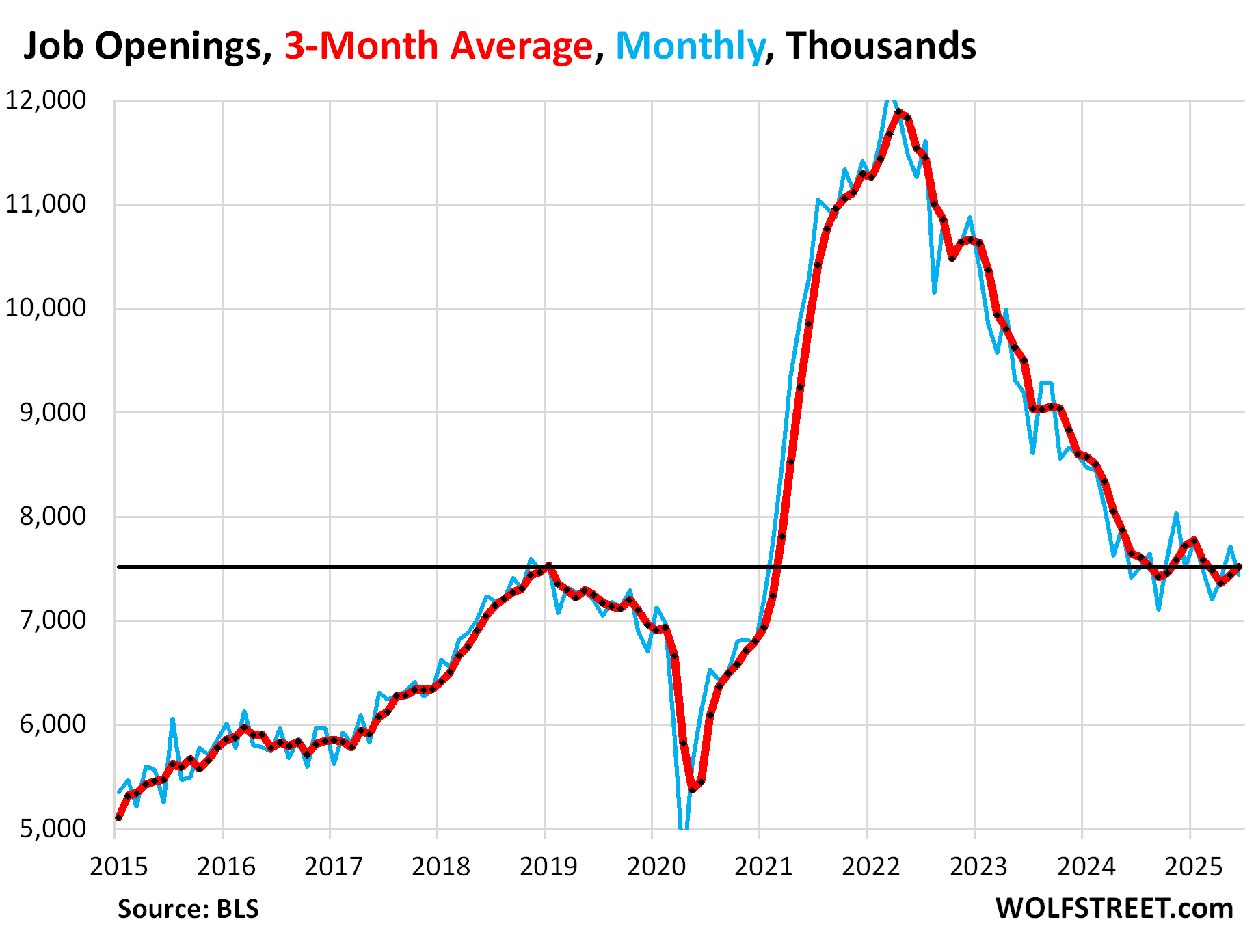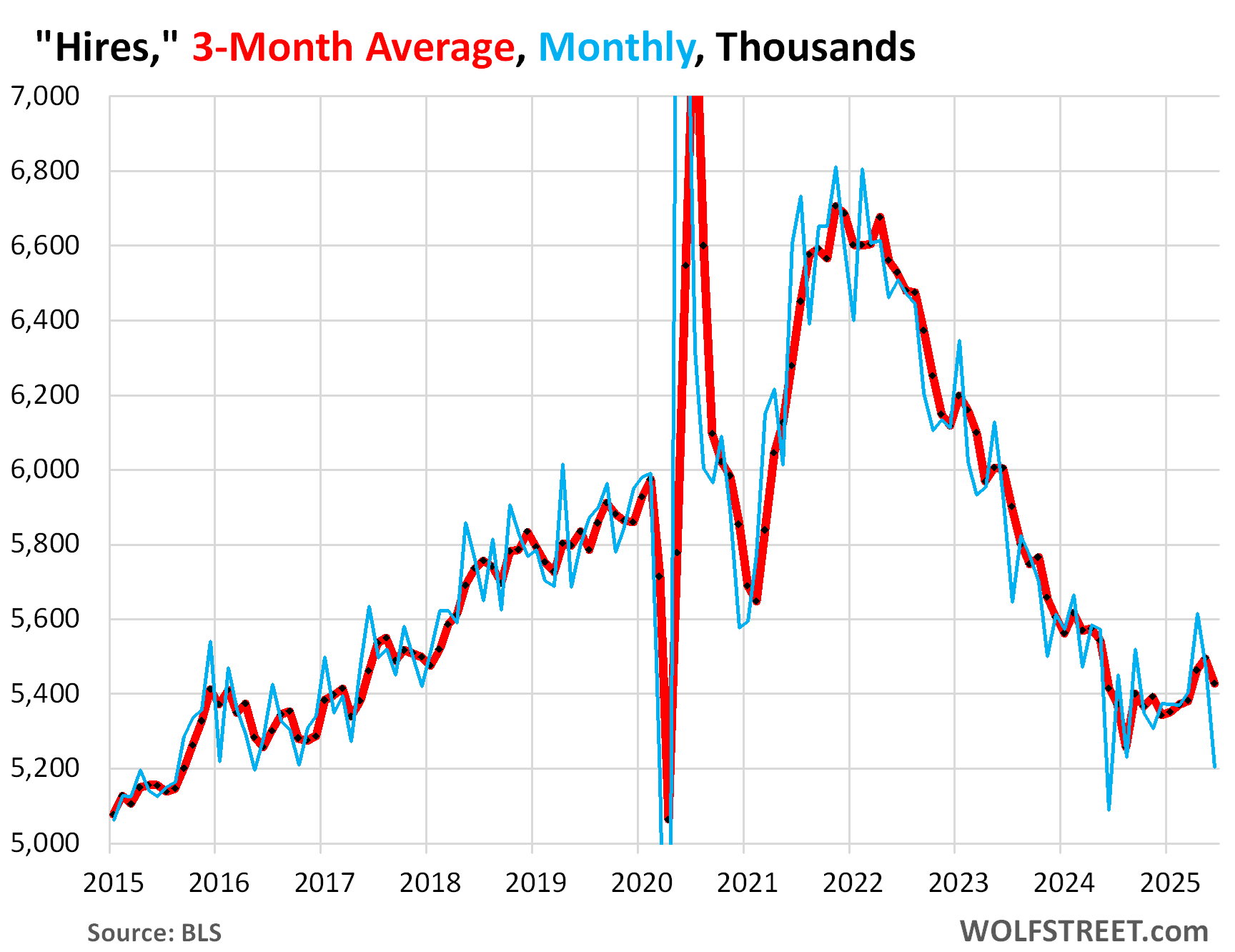The epic red-hot turnover in the labor market in 2021 and 2022 that had reshuffled the entire work force is over.
By Wolf Richter for WOLF STREET.
Churn in the labor market – how many workers quit voluntarily to work somewhere else, how many were discharged for whatever reason, how many retired or died, and how many were hired to fill these left-behind job openings – had gone on a wild ride in 2021 and 2022.
That kind of epic labor market churn was expensive and inefficient for companies, but it ended up massively reshuffling where people worked, possibly producing better matches between skillsets and aspirations, which would be a positive outcome. And this churn has now settled down.
This labor market “turnover,” as it’s called officially, is tracked by the Job Openings and Labor Market Turnover Survey (JOLTS), released today for the month of June, by the Bureau of Labor Statistics. As the name says, it’s about turnover in the labor market. It is not about new jobs or new hires; that’s part of the jobs report, and in June, job creation was solid. The jobs report for July will come out on Friday.
The JOLTS data, based on surveys of 21,000 work sites, jumps up and down from month to month – monthly “squiggles” is the official WOLF STREET term for it – and so for inspiration, we look at the three-month average, which irons out a portion of those squiggles.
The principle of churn is this: People who quit their jobs (“quits”), or got laid off or fired (“layoffs and discharges”), or retired or died (“other separations”) leave vacant slots behind (“job openings”) that companies will eventually fill (“hires”). Those are the big elements of labor market turnover.
Quits fell by 128,000 in June from May to 3.14 million workers, seasonally adjusted, who walked out of their jobs voluntarily, such as to take a better job somewhere else. They do not include retirements, deaths, etc. (blue in the chart).
The three-month average quits declined by 67,000 to 3.21 million quits, roughly the same as in March (red in the chart). The low point in quits was in late 2024.

The epic high quits in 2021 and 2022 were a sign of massive churn in the labor market. It means that workers quit their jobs to take a better job somewhere else. This was how wage increases spread like wildfire through the labor market from industry to industry, as employers tried to retain who they had, and tried to hire to fill those slots left behind by the quitters.
The much lower 3.1 million quits in June show that workers have found some greener grass elsewhere and that employers, with their layoff announcements starting in mid-2022, have successfully scared workers into staying put.
Fewer quits means fewer job openings left behind, and fewer people that need to be hired to fill those job openings.
Layoffs and discharges inched down by 7,000 in June from May, to 1.60 million, seasonally adjusted, the lowest since March, and both were the lowest since June last year.
The three-month average inched up by 5,000 in June from May, to 1.67 million, and both June and May were the lowest since August 2024, and below the pre-pandemic Good Times low.
During the massive churn in the labor market in 2021 and 2022, layoffs and discharges had plunged to record lows as employers had trouble holding on to whoever they still had on the payroll that hadn’t quit yet.
That layoffs and discharges rose from those record-low levels is another sign, along with quits, that the massive churn in the labor market has calmed down, and that there are fewer left-behind vacant slots (job openings) that need to be filled.

Other separations (retirements, deaths, etc.) totaled 367,000 in June, compared to 1.60 million layoffs and discharges and 3.14 million quits. They’re a small-ish but constant factor. They have been in that range for the past three years. The resulting job openings also need to be filled with hires.
Job openings fell by 275,000 in June from May, to 7.44 million openings, undoing part of the big jump in May.
The three-month average rose by 79,000 in to 7.52 million openings, the second month in a row of increases, matching the peak of the pre-pandemic Good Times – another sign that the churn in the labor market has leveled off.
Job openings are mostly a result of quits, layoffs and discharges, and other separations (retirements, deaths, etc.). Only a small portion of these 7.5 million openings represent newly created job openings; Friday’s jobs report will shed more light on those.

Hires declined by 261,000 in June from May, to 5.20 million, seasonally adjusted, which had been the largest hiring spree since February 2024.
Note that the 5.20 million in hires exceeded the 5.11 million slots left behind by quits (3.14 million), layoffs and discharges (1.60 million), and other separations (367,000).
The three-month average declined by 67,000, to 5.43 million hires, the first decline after five months in a row of increases.
Most of these 5.2 million hires in June replaced workers who’d quit their jobs, or who were discharged or laid off for whatever reasons, and who’d retired or died. Only a small portion were hired to fill newly created jobs.
The low number of quits and the low number of layoffs and discharges means that companies need to hire fewer people to fill the job openings left behind.

What all this means is that turnover in the labor market has calmed down from the epic red-hot churn in 2021 and 2022 when employers had trouble hanging on to their workers and had trouble hiring replacements, as workers quit massively to go for better jobs somewhere else, and when the whole labor market was reshuffled in a span of two years.
Enjoy reading WOLF STREET and want to support it? You can donate. I appreciate it immensely. Click on the mug to find out how:
![]()


The “golden handcuffs mortgage” is used to explain lower housing supply, but it would also make sense that we would see less selling after a period where people reshuffled into jobs that produced “better matches between skillsets and aspirations.”
1. “The “golden handcuffs mortgage” is used to explain lower housing supply,”
The meme that was so hot yesteryear didn’t age well. Supply is spiking:
https://wolfstreet.com/2025/07/23/single-family-home-sales-drop-below-1995-supply-highest-since-2016-condo-sales-at-low-in-the-data-supply-at-housing-bust-level/
2. “we would see less selling after a period where people reshuffled into jobs that produced “better matches between skillsets and aspirations.””
Yes, could be a factor.
While the Golden Handcuffs Mortgages are a big factor in the current housing market, High Interest Rates are a bigger factor.
It is quite possible for both of these things to be true.
It is also possible for them to not cancel out.
I hate whomever writes the JOLTS report PR. Saying X metric “was little changed” is not helpful. At least say slightly increased or slightly decreased. Thank you Wolf for summarizing JOLTS so I don’t have to look at that nonsense PR.
Labor turnover is now about back to something close to normal — and that’s all this “Job Openings and Labor Turnover Survey” (JOLTS) is reporting on.
I started covering it when it went haywire during the pandemic. And now it has settled back down.
So this was probably my last monthly update — though I might still do an occasional update. When labor turnover is in the normal range, it’s really not a big factor anymore.
This data says zero about new jobs or job creation or total jobs. That data will come out on Friday.
What are your thoughts on AI decimating the job market? Would you happen to have an article written on that that I could read? Thanks!
That would be pure speculation, on a wing and a prayer, no matter who comes up with it. And I don’t do that in the articles. But in the comments occasionally, it’s fun to speculate just for the heck of it. So why not occasionally…
We already know, AI will:
— replace many skilled workers, or at least part of what they do, such as in tech, administration, law, marketing, advertising, media, publishing, film, transportation (drivers!), call centers, tech support, healthcare, etc.
— increase employment of people that deal with AI and the software, infrastructure, equipment, and energy it requires. That’s a biggie.
— create new jobs in new professions and new industries that will spring up as a result. Even silly stuff like all the AI conferences and the AI training courses that are coming out like mushrooms everywhere… these are all new jobs.
So we kind of see this happening already.
What we don’t know yet is how that works out on net. The internet was going to destroy jobs too, and it did destroy a lot of jobs, but created lots of new jobs in all kinds of new industries that didn’t exist before, including online publishing, and therefore my job right here.
So it goes with every technology. It destroys jobs, and it creates jobs. How AI will work out on net is pure speculation though. Lots of smart people are worried that AI will be the first big technology that will on net reduce jobs.
I’m not at all convinced this is the case. People are really a creative bunch, in my experience.
Chip making, power generation (which requires local power providers to scale up human and capital resources), data center construction, etc
Great points. One thing I would add: the number of jobs created/destroyed does not match the number of people who are made chronically unemployed or underemployed by the technology. People simply do not “retrain” as fast or as easily as technology pundits tend to assume or as technology apologists tend to claim.
Correct. That happens every time there is a major technological transition. It’s a really bad deal, if you’re caught up in it.
4h/Wolf-excellent observations…
May we all find a better day.
Well said!
Slop generators are massively over-hyped. AI will end up replacing very few, if any jobs, I predict.
It will though create lots of BS jobs, conventions, marketroids, etc. as you point out.
Reminds me of 30 years ago when in the weekly meeting with the operations manager he told the men he could get a monkey to do their job. They didn’t think that was funny.
I’m surprised that “other separations” isn’t increasing. Have the baby-boomers all retired? I am also surprised that spending by the increasing number retires doesn’t seem to be putting upwards pressure on bond yields.
Thanks,
Michael
Baby boomer started retiring 15 years ago and will continue to retire for another 10-plus years. The youngest boomers are now 60. Generations are a flow, not a level. Most of my boomer friends who have their own shops are still working and have no intention of retiring. I’m not retiring either. Retirement is overrated. It takes decades to the wash a generation out of the labor market.
Also note that the GenZ and Millennials are now the largest generations. And they’re now deep in the labor market, and it’s not like the boomers were the first generation to ever retire.
My first couple attempts at retiring were SO boring after a few months I choose to go back to work and did, though ageism certainly added to the challenge.
Now in my 80s, it’s more fun to sit back and just enjoy every day at play — so to speak…
Several friends who said they were only going to play golf or go fishing or whatever in their sixties died very soon, so better to find something to work at into at least your late 70s IMVHO.
I “retired” at 48 yrs old. Had I not, I think the stress would have killed me by 60 yrs old.
Everyone has their thing. I do a lot of nothing, and happy to do that. Mostly a lot of economics reading, some learning Spanish and a musical instrument, time with friends, some travel, various distractions. Kids live 1600 miles away & are grown do I don’t bother them much.
Everyone is different. I’d hate to have to work f/t as I hit mid-60’s, but then I have various joint issues that most dont have.
Vintage,feel I will work in some ways till the day I die,the difference being will be doing jobs I want when I want to keep me busy and not living(?) out of a bottle a lot will be as I do now,helping friends on their places and basically get paid in a few meals.
I get the acreage I want will also have goats for milk and bitter/chickens for eggs/garden which that with cats and dogs will keep me moving!
I was one of many who quit due to being forced to take medicine I did not want to keep me job(good paying construction),6 folks left the company like me.
Was fun when they called 6 months later and wanted me on a new gig,said mandates for supposed medicine over,to which I reminded them they told me I needed them more then they needed me,was a fun day!
I know many nurses who left hospitals/joined travelling nurses and ended up working at same hospitals for more monies without “medicine” mandates,was a really surreal time in the economy /world and we are still paying a heavy price.
300,000 Americans died, who would otherwise have survived, because they would not take that medicine, because they read something on the internet, or heard something on a podcast. And many more than that needed hospital resources, who would not have needed it, using resources that could have gone to others, because they refused the medicine. They “did their research”, took their chances, and they paid a heavy price for it.
Sounds like it worked out for you though, so good for you.
It’s always amazing to see how many equate luck with skill or knowledge or self importance. I’ll stick with science, especially when it comes to Medicine.
It takes a certain amount of audacity to pull up stakes and leave your job for greener pastures. The American worker is one of the more ballsy creatures on the planet, driven by a need to improve himself through new experiences (and better pay!!!). I’m a little disappointed that the job churn has slowed down, although the hardcore strivers will always have a plan B to resort to when their current job site is stagnating.
Re: “turnover in the labor market has calmed down from the epic red-hot churn in 2021 and 2022”
Somewhat, semi-related job churn stuff, accidentally stumbled on:
Sectoral Determinants of Aggregate Productivity Growth
Richmond Fed February 2025, No. 25-08
“We should expect little to no help from AI to make the aggregate economy more productive”
“It may be that AI eventually bleeds into other sectors such as retail services, but a 2024 paper calculates that at most 5 percent of tasks across all sectors will be meaningfully impacted by AI over the next decade.6”
Additionally, watched a decent recent, YouTube interview with Liz Ann Sonders, and she mentioned, the overlooked economic effects of immigration policy.
Combined, in these stories, is labor churning in a very new way — although there’s clear normalization after the pandemic shock, were transitioning into a new phase that mixes unknown immigration dynamics, with the implementation of quirky, uneven AI labor impacts — into a fairly hesitant economy, that’s apparently resilient, as it screams ahead into a future, where GDP is sputtering.
If anything, I imagine that anyone with a job, will remain terrified going forward.
Staying has its merits, though sometimes hard to see through the sleaze.
My wife has been offered so many new gigs, it’s pitiful, but everyone of them comes with a lateral move base salary-wise, with promises of fat commissions. We already treat her current bonuses which are usually 6-figure sums as “unobtainium” just in case, and never factor those into our living expenses.
She’s maxed out on vacation and sick time as well, which also goes a long way to keeping her retention. Why would she want to move for the “hopium” of bonuses?
It would probably take a 30% base increase, plus additional bonus structures to ever make her move. She’s happy to just keep walking over the competition with her experience and tenure at the moment, probably netting more commission anyway due to market penetration.
Grass isn’t always greener…
The AI impact on high paying tech sector is yet to come. Will be way worse than what you think, I expect 30% loss of job in tech in next 3 years.
Medicine may also follow with AI outsmarting physicians in radiology.